- Contents
- 21st Century Skills
- Cross-Curricular Activities Through Arts and Crafts and English with Young Learners
Cross-Curricular Activities Through Arts and Crafts and English with Young Learners
Editorial
This article is part of Project 08-138/08.02.2018 of Dobrich College, Shumen University
Zhivka Ilieva is an associate professor at Dobrich College, Shumen University. She has a PhD in Methodology of English Language Teaching. As part of her research she has classes at primary schools and at kindergartens. She presents at conferences dedicated to language teaching and teacher training in Bulgaria and abroad. E-mail: zh.ilieva.bg@gmail.com
Iliya Iliev is an assistant professor at Dobrich College, Shumen University. He teaches primarily methodology of teaching arts and crafts to future primary and pre-primary teachers. E-mail: iliya.iliev@shu.bg
Introduction
Arts and crafts combined with English provide opportunities for a variety of cross-curricular links. They develop children‘s habits to work precisely, to keep clean and tidy their working place and also foster their creativity.
Integrating English and other subjects gives rich context for introducing and practising phrases. Phrases learned this way are retained longer in memory because the context is memorable – practising language while working creates associative links. Integration with various subjects caters for easy learning by learners with various interests. “Building“ houses realizes links to Mathematics and natural sciences when done with natural materials.
Cross-curricular links
Different subjects ensure introducing and practising material in different ways (e.g. arts and crafts – learning by doing) this way catering for fostering the different learning styles and for the development of all intelligences. Bertrand (2009) accentuates that when working with very young learners and young learners “it‘s especially important to cater to the different learning styles“. Troubridge (2006) states that with very young learners and young learners arts and crafts ensure cross-curricular activities; they provide suitable medium for kinaesthetic and visual / spatial learners. These activities can be used for introducing language in English after the children have practised the same notions in their native language. Usually new material is introduced in the morning (e.g. in mathematics classes children learn flat shapes and shapes) and the same material is practised in the afternoon during arts and crafts activities. These activities are used to introduce and practise the corresponding vocabulary (e.g. shapes and flat shapes) in English.
Trowbridge (2006) recommends introducing vocabulary needed during the activity (“Can I have ...?“) as well as instructions, and lexis needed in the follow up activities while children comment each other‘s work. While receiving instructions, asking for favours their classmates during work and while making comments, learners acquire words for materials (e.g. paper, beads, seeds and plant names), tools and instruments (scissors, pencil, ruler, triangle) and various activities (draw, cut, arrange, paste).
Some authors (Trowbridge 2011, Bertrand 2009) emphasize the teachers‘ preparation (e.g. ready made elements) without losing the „creative element of the activity“ (Bertrand 2009), samples of the ready made item and an item for each stage of the activity, templates, enough tools and materials and the need of communication and proper instructions during tidy up time (Trowbridge 2011). They (Trowbridge 2011, Bertrand 2009) accentuate need of precise explanation combined with demonstration and a lot of praize. As Ilieva and Iliev (2017) state these activities foster creativity, language and communicative skills development “as well as crafts and design skills and sense of arrangement and beauty“, and also develop “children‘s technological culture (folding, being precise, coordination, arranging and then pasting).“
According to Ellis (2016: 29) early years foreign language education “involves acknowledging and recognising children‘s drawings, constructions, arts and crafts and actions as alternative ways of communicating with the teacher about their world in a foreign language. It also invites the teacher to use multimodal input and resources.“
Having in mind Bertrand‘s (2009) recommendation “vary the type of craft supplies you use – be innovative“, we can offer a few activities for young learners of various ages united by the product (a house) where different kinds of materials and techniques of work are used. This way cross-curricular links to almost all subjects are realized: arts and crafts, mathematics (flat shapes and drawing), nature world (seeds and nuts, shells or pebbles and the topic of sea / river), social world (types of houses people live in) and homeland science (introducing the buildings typical for the region the learners live in), music (listening to music while working).
“Building“ houses
- Applications
- With very young learners we use making houses to reinforce the flat shapes (triangle, square, rectangle, circle). With the youngest we have to prepare all the elements so they can only assemble the item. With older learners, we show an example and they cut out shapes and arrange them. (figures 1- 4).
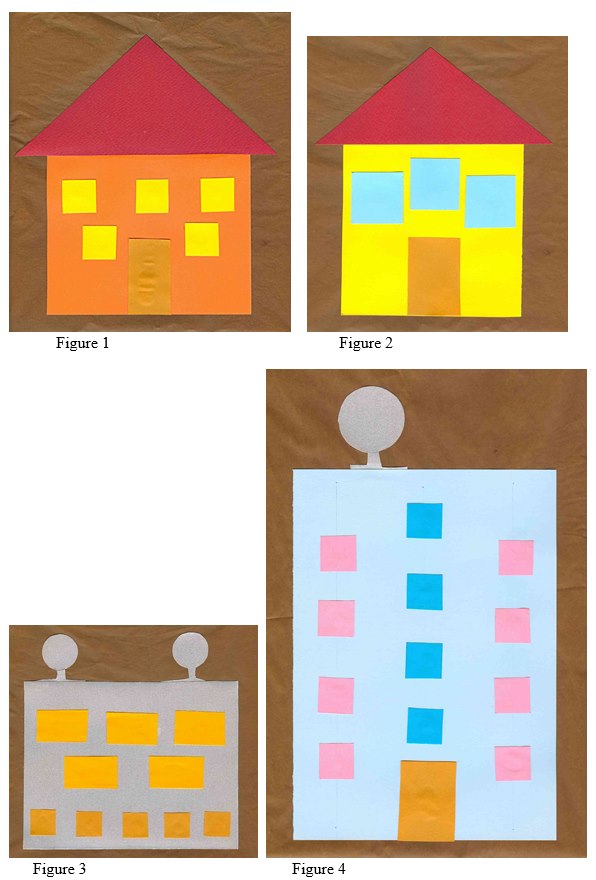
- Applications with various materials: seeds (fig. 5), beads (fig. 6), shells / pebbles (fig. 7 and 8), yarn and threads (fig. 9). This includes 1. drawing the contours of the object (in this case a house), 2. making a project – arranging the picture with the corresponding material, 3. carefully pasting the pictture. Younger learners receive a piece of paper with the contours of a house which they arrange. Older learners (4th group) themselves draw the contours using a ruler, a triangle and a pencil.
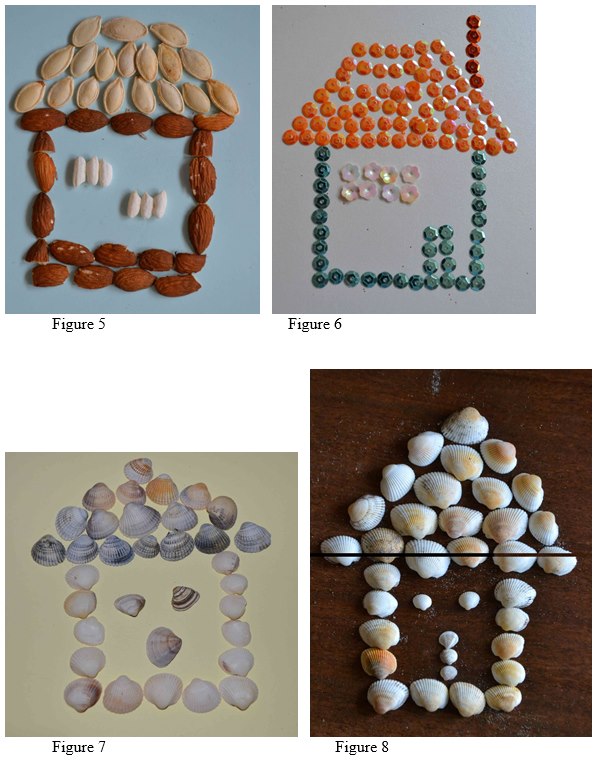
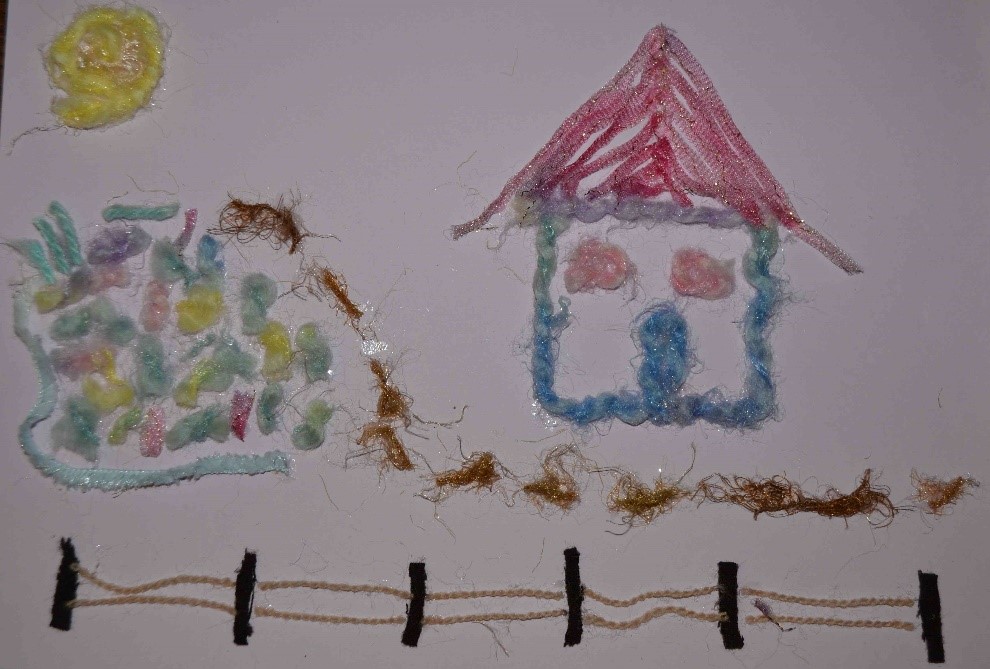
Figure 5 provides context for practising the plants and nuts names, e.g. in this case we have almonds and pumpkin seeds, there might be sunflower seeds, walnuts, linen seeds, beans, lentils, wheat, corn etc. The use of these seeds and nuts may be discussed as well as their role in healthy lifestyle.
Figure 6 gives opportunity for practising colours, the parts of the house (roof, windows, door, chimney), singular and plural (a window / (2) windows) and pronunciation (the semivowel [w]).
Figures 7 and 8 provide context for practising flat shapes and parts of the house and for discussing the environment (in this case sea and shells), if we use pebbles instead of shells – river, mountain and the surrounding relief.
Figure 9 provides context for discussing types of houses and surrounding: in this example a house with yard, fence, flower beds, flowers and colours, flowers and seasons.
- Constructors
There are various types of constructors. Depending on the age of the pre-school children, different constructors are used. In one of them the elements are like parts of buildings (a block of flats, a house, a roof (fig. 10)), another consists of shapes that can form various items, including houses (fig. 11). Both are suitable for the very young. The second one can be used as elements for application or like the elements of the first constructor depending on how the children arrange them – on a piece of paper horizontally or vertically as if building a house.
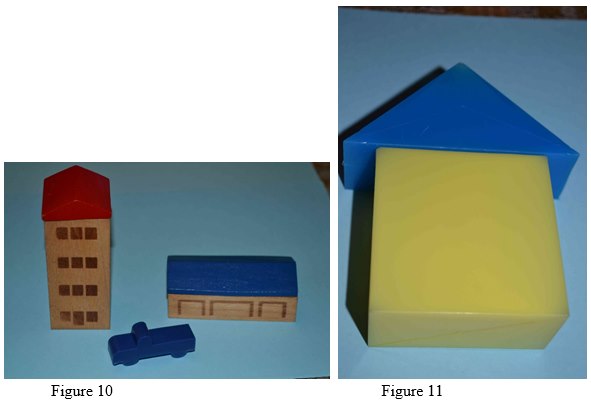
Another constructor gives the older learners an opportunity to construct houses. The simplest construction is a garage (fig. 12). The next stages are a house with a flat roof (fig. 13) and the more complex ones on figures 14, 15 and 16 – there are doors and various types of windows.
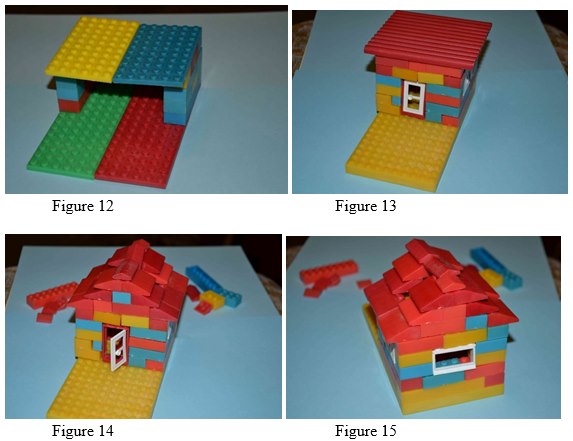
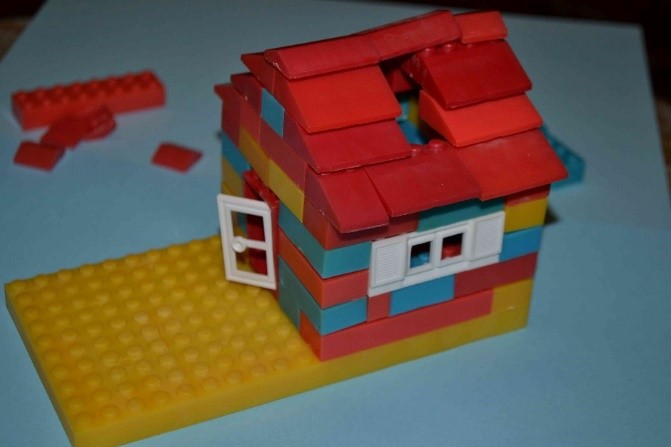
- Paper houses
The simplest houses suitable for 1st group children (3 years old) are made of a square, folding it once. The squares are prepared by the teacher.
- Take the square. Take one apex and put it on the opposite one, work precisely. Hold the two apexes and fold the paper precisely so that you receive a triangle. Make a lasting edge. (fig. 17 and 18)
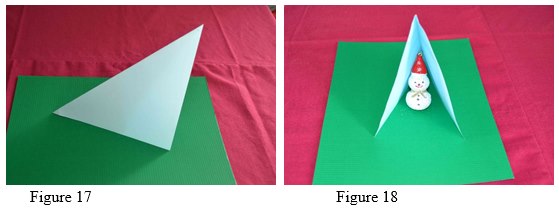
- Take the square. Take two neighbouring apexes and put them over the opposite ones. Hold them tight and fold the paper so that you receive a rectangle. Work precisely. Make a lasting edge. (fig. 19)
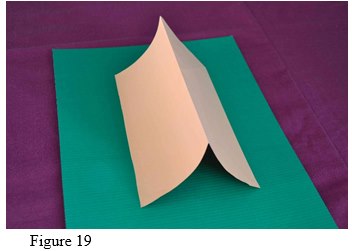
These activities develop the skills to fold and work precisely from an early age.
- More complex houses are made like geometrical figures (a cube or parallelipiped and a pyramid). In this case learners receive the figure unfolded they can cut it out, fold it and glue. Sometimes the unfolded figure may be cut out so that it would be easier for the children to work. (fig. 20, 21, 22, 23). The examples show that some children choose to cut out door and windows while others use stickers to illustrate the inhabitants of the house or door and windows which gives opportunities for further vocabulary work. In this case we have a door made of oak leaves and various types of owls on the windows.
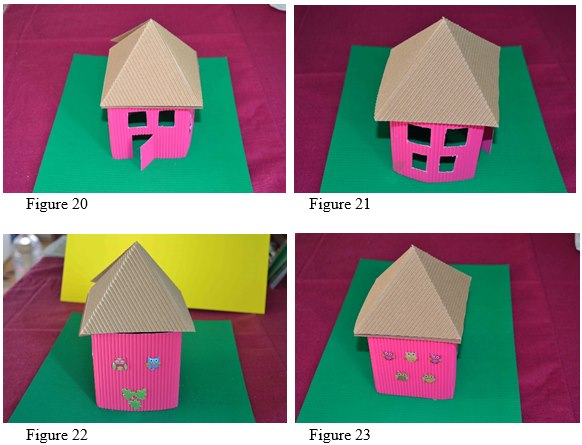
- Natural materials
Natural materials are seeds and nuts, shells and pebbles (fig. 5, 7 and 8), fir cones, moss, lichen, leaves. Activities may be application (fig. 5, 7 and 8) or construction (fig. 24) – making a house like on figures 20-23 and covering it with natural materials (fig. 24).
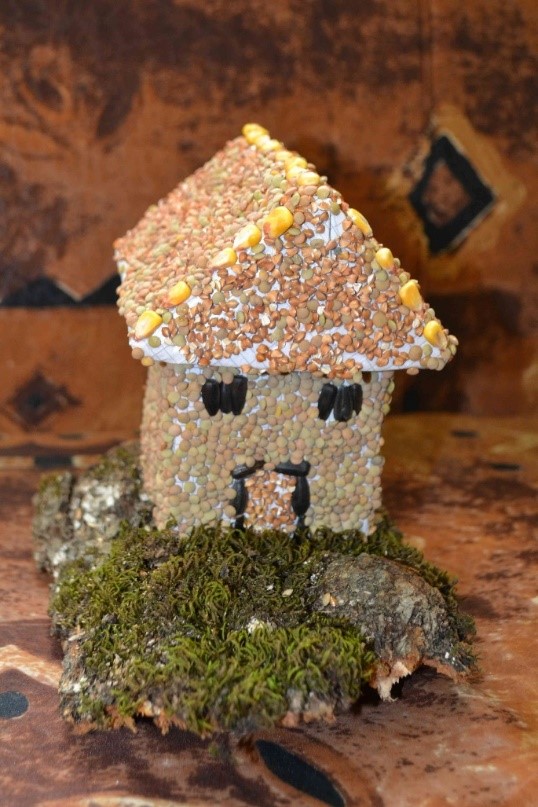
Conclusions
Through these activities children acquire words for materials, tools and instruments and various activities in English. They gradually learn the sequence of the activities:
Applications:
- Prepare the working place
- Take a piece of paper
- Design a project (draw contours and / or arrange the elements)
- Paste
- Wait until it is dry
- Arrange your work at the exhibition area in the classroom
- Clean your working place.
Origami / Folding
- Prepare the working place
- Take a piece of paper
- Take ... apexes and put them over the...
- Hold them tight and fold the paper so that you receive a ... Work precisely.
- Make a lasting edge.
- Arrange your work at the exhibition area in the classroom
- Clean your working place.
Steps 1, 6 and 7 exist in all instructions (when making applications, origami or when working with constructors). They develop childrens‘ habits to keep their working place clean and tidy and to be proud of their work.
The activities illustrated ensure cross-curricular work uniting English and arts and crafts with other subjects thus providing rich context for lexical and grammatical work and for discussions this way leading to long lasting language acquisition.
References
Bertrand, J., (2009). Using arts and crafts arts in English Lessons. https://www.teachenglish.org.uk/article/using-arts-crafts-arts-english-lessons
Ellis, G. (2016). Promoting ‘Learning‘ Literacy through Picture Books: Learning How to Learn. CLELEjournal, 4 (2), 27-40.
Ilieva, Zh. & Iliev, I. (2017). Creativity and Arts and Crafts in Teaching English to Young Learners. Humanizing Language Teaching, 19 (5). http://www.hltmag.co.uk/oct17/sart04.htm
Trowbridge, S., (2011). Kids and arts and crafts. https://www.teachenglish.org.uk/article/kids-arts-crafts
Trowbridge, S., (2006). Arts and crafts with young learners. https://www.teachenglish.org.uk/article/arts-crafts-young-learners
Please check the Creative Methodology for the Classroom course at Pilgrims website.
Please check the 21st Century thinking Skills course at Pilgrims website.
Please check the Methodology and Language for Kindergarten course at Pilgrims website.
Please check the Methodology and Language for Primary course at Pilgrims website.
Remote Theatre: Communicating Creatively Across Cultures Through Screen Technology
David Heathfield, EuropeOn Embracing Change: Observations From a Technophile
Daniel Martin, SpainCross-Curricular Activities Through Arts and Crafts and English with Young Learners
Zhivka Ilieva, Bulgaria;Iliya Iliev, Bulgaria